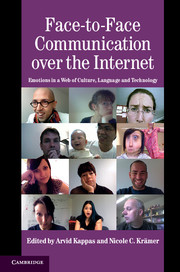Book contents
- Frontmatter
- Contents
- Preface
- Contributors
- Abbreviations
- Introduction
- Part 1 General aspects of visual cues in CMC
- Part 2 Video- and avatar-based communication
- 4 Nonverbal communication and cultural differences: issues for face-to-face communication over the internet
- 5 Video-linking emotions
- 6 Impact of social anxiety on the processing of emotional information in video-mediated interaction
- 7 Facing the future: emotion communication and the presence of others in the age of video-mediated communication
- 8 Virtual gestures: embodiment and nonverbal behavior in computer-mediated communication
- Part 3 Emotions and visual cues in HCI
- Index
- Studies in Emotion and Social Interaction
- References
4 - Nonverbal communication and cultural differences: issues for face-to-face communication over the internet
Published online by Cambridge University Press: 05 June 2012
- Frontmatter
- Contents
- Preface
- Contributors
- Abbreviations
- Introduction
- Part 1 General aspects of visual cues in CMC
- Part 2 Video- and avatar-based communication
- 4 Nonverbal communication and cultural differences: issues for face-to-face communication over the internet
- 5 Video-linking emotions
- 6 Impact of social anxiety on the processing of emotional information in video-mediated interaction
- 7 Facing the future: emotion communication and the presence of others in the age of video-mediated communication
- 8 Virtual gestures: embodiment and nonverbal behavior in computer-mediated communication
- Part 3 Emotions and visual cues in HCI
- Index
- Studies in Emotion and Social Interaction
- References
Summary
Overview: The various forms of interpersonal communication that take place on the internet are considered and several questions concerning the efficacy of interpersonal communication over the internet are raised (i.e., whether this form of communication can be compared to actual face-to-face communication).
The technologies for communication over the internet do not always allow access to “kinesic” behaviors through the visual channel or to vocal-intonational modulations of speech through the auditory channel; they therefore cannot count on a wide range of nonverbal signals that are of extreme importance for certain communicative processes. Graphic and linguistic strategies permit internet users to compensate for this lack of communicative signals and render communication via the internet more immediate, natural, spontaneous, and expressive. Videoconference might be an effective means for conveying the sense of presence to interlocutors; it can be used in many different areas: in work (long-distance collaboration and meetings between people in different locations), long-distance education (teleteaching, e-learning), and health care (telemedicine, telehealth, psychotherapy), as well as in legal contexts.
This contribution, finally, analyzes the video-based interactions between individuals belonging to different cultures and evaluates the differences in nonverbal communication in this perspective.
Introduction
The internet is now a means of communication widely used in the interaction between individuals: It is used for work, to chat with friends, to meet new people, to discuss matters of social importance, for educational purposes, etc. The videoconference has now been added to the most frequently used systems (email, discussion forums, mailing lists, etc.
- Type
- Chapter
- Information
- Face-to-Face Communication over the InternetEmotions in a Web of Culture, Language, and Technology, pp. 81 - 99Publisher: Cambridge University PressPrint publication year: 2011
References
- 13
- Cited by

